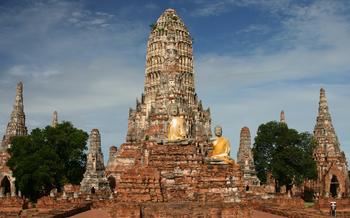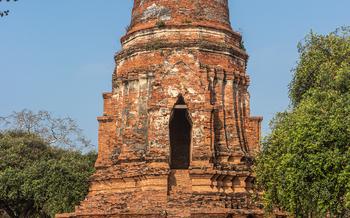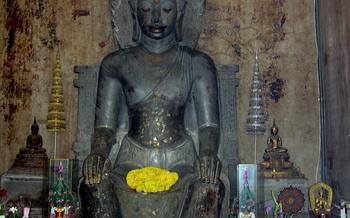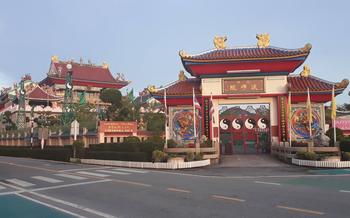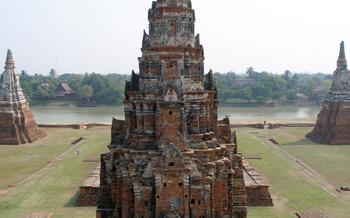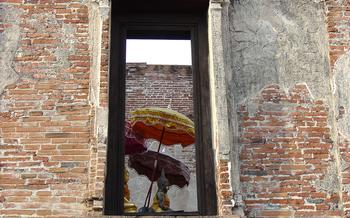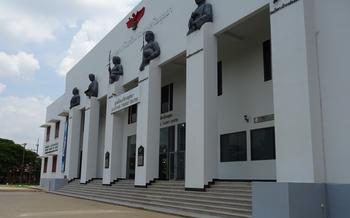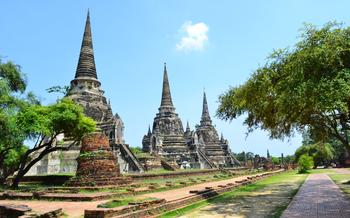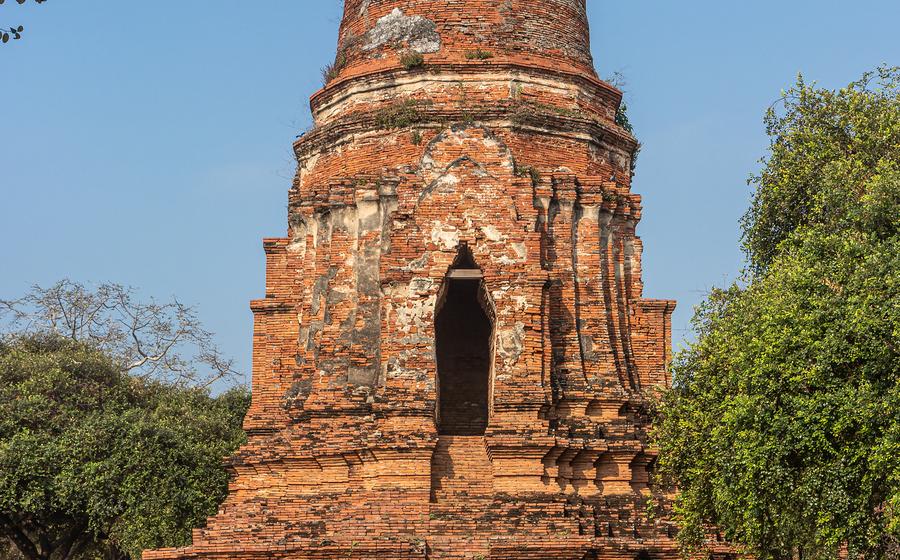
Wat Taka Rong
- Historical Significance
- Architectural Beauty
- Royal Connections
- Ceremonial Importance
- Restoration Efforts: Preserving History at Wat Taka Rong
- Unique Features
- Exploration of the Grounds
- Photography Tips
- Local Cuisine
- Cultural Immersion
- Historical Context
- Getting There
- Nearby Attractions
- Insider Tip
Historical Significance
Wat Taka Rong stands as a testament to the grandeur and artistry of the Ayutthaya Kingdom. Constructed under the reign of King Narai the Great in the 17th century, it served as a royal temple, hosting religious ceremonies and important events for the royal family and the kingdom. The temple's architectural splendor and historical significance have earned it a prominent place among the many temples in Ayutthaya, inviting visitors to delve into the rich cultural and spiritual heritage of Thailand.
Architectural Beauty
Wat Taka Rong stands out among Ayutthaya's many temples for its unique architectural features. Its most striking element is the impressive white chedi, a towering spire that dominates the skyline. The chedi is adorned with intricate stucco decorations, which depict scenes from Buddhist mythology and the life of Buddha. The chedi's base is surrounded by a series of smaller stupas, each with its own unique design and ornamentation.
The temple's main building, the viharn, is also a sight to behold. Its interior walls are covered in colorful murals depicting scenes from the Jataka tales, which recount the previous lives of Buddha. The murals are a testament to the skill and artistry of the Ayutthaya craftsmen who created them.
The temple grounds are also home to a number of other interesting architectural features, such as a bell tower, a library, and a residence for the monks. These buildings are all constructed in the same style as the main temple, and they contribute to the overall harmony and beauty of the complex.
Royal Connections
Wat Taka Rong's royal connections run deep, weaving a tapestry of history and devotion. Built under the patronage of King Narai the Great, the temple served as a venue for royal ceremonies and events, witnessing the grandeur of Ayutthaya's monarchy. The temple's association with the royal family extended beyond its construction, as it became a place of worship and contemplation for successive generations of kings and queens.
One notable anecdote highlights the temple's significance in royal life. During the reign of King Rama IV, a grand Kathin ceremony was held at Wat Taka Rong, attracting a vast assembly of monks and devotees. The king himself graced the occasion with his presence, leading a procession of royal barges along the serene waters of the Chao Phraya River. The opulent ceremony showcased the temple's central role in the religious and cultural life of the Ayutthaya kingdom.
Through the centuries, Wat Taka Rong has remained a cherished symbol of royal patronage, embodying the deep connection between the monarchy and the Buddhist faith in Thailand.
Ceremonial Importance
Wat Taka Rong holds great significance as a venue for important religious ceremonies and events that showcase Thailand's rich cultural heritage. The annual Kathin ceremony, held during October or November, is a major highlight. During this grand occasion, monks from neighboring temples gather at Wat Taka Rong to receive new robes, known as "Kathin." The ceremony is marked by vibrant processions, where the monks parade through the temple grounds, accompanied by traditional music and colorful umbrellas. Devotees and visitors alike come together to offer their support and participate in this sacred ritual, creating a lively and festive atmosphere.
Beyond the Kathin ceremony, Wat Taka Rong hosts various other festivals and rituals throughout the year. These events provide an opportunity for visitors to witness the deep-rooted spiritual traditions of Thailand and gain a glimpse into the vibrant local culture. Whether it's the Makha Bucha festival, celebrating the teachings of Lord Buddha, or the Songkran festival, marking the traditional Thai New Year, Wat Taka Rong becomes a hub of religious devotion and cultural expression.
Restoration Efforts: Preserving History at Wat Taka Rong
Wat Taka Rong, like many historical landmarks, has faced the ravages of time and natural elements. Over the years, extensive restoration work has been undertaken to preserve its historical integrity and architectural splendor. The process of restoring the temple's intricate details and architectural features has been a complex and challenging endeavor.
Skilled artisans and craftsmen have meticulously worked to recreate the original designs and motifs that adorn the temple's chedi and surrounding structures. The delicate stucco decorations, colorful ceramic tiles, and intricate carvings have been painstakingly restored to their former glory. The restoration efforts have required immense precision and attention to detail, ensuring that the temple's unique character and historical significance are maintained.
The successful restoration of Wat Taka Rong stands as a testament to the dedication and expertise of the individuals involved. Their efforts have not only preserved this architectural masterpiece but also ensured that future generations can continue to appreciate its beauty and cultural significance. The restored temple serves as a reminder of the enduring legacy of Ayutthaya and the importance of preserving our historical heritage.
Unique Features
Wat Taka Rong stands out among other temples in Thailand due to its distinctive characteristics. One remarkable feature is the presence of Chinese-style guardian lions, known as "shishi," which flank the entrance to the temple. These majestic creatures, with their fierce expressions and intricate details, symbolize protection and ward off evil spirits.
Another unique aspect of Wat Taka Rong is its layout and design. The temple's main chedi is surrounded by a series of smaller chedis, creating a visually striking and harmonious ensemble. This arrangement reflects the temple's dedication to multiple Buddhist deities and represents the interconnectedness of the spiritual realm.
Moreover, Wat Taka Rong showcases exceptional architectural ingenuity in its overall design. The temple's buildings and structures are meticulously positioned to create a sense of balance and symmetry. Visitors can admire the intricate patterns formed by the chedis, stupas, and surrounding structures, which together create a visually captivating landscape.
Exploration of the Grounds
Begin your exploration of Wat Taka Rong by marveling at the grand main chedi, the temple's centerpiece. Adorned with intricate stucco work and colorful ceramic tiles, it stands as a testament to the artistic prowess of the Ayutthaya era. Capture its grandeur from various angles to fully appreciate its intricate details.
Next, take a leisurely stroll around the surrounding stupas. These smaller chedis, arranged in a harmonious pattern, create a sacred atmosphere and offer unique photographic opportunities. Remember to respect the religious significance of these structures and maintain a respectful distance.
As you wander through the serene courtyard, admire the meticulously manicured gardens and the tranquil ponds that add to the temple's peaceful ambiance. Take a moment to sit and soak in the tranquility, allowing the temple's serene energy to wash over you.
Remember to explore the temple at a leisurely pace, allowing yourself ample time to appreciate its many wonders. Embrace the opportunity to immerse yourself in the history, culture, and spirituality that Wat Taka Rong embodies.
Photography Tips
Capturing the essence of Wat Taka Rong through photography requires a keen eye and an understanding of lighting conditions. For the most striking shots, position yourself in front of the main chedi, ensuring the entire structure is visible. Utilize a wide-angle lens to capture the grandeur of the temple against the vast sky. To highlight the intricate details of the chedi's stucco decorations and ceramic tiles, opt for a telephoto lens. Experiment with different angles to create dynamic compositions, such as shooting from a low perspective to emphasize the height of the chedi.
When it comes to lighting, the golden hour, just before sunset, offers the most flattering light for photography. The warm hues of the setting sun will illuminate the temple's white chedi, casting a soft glow that enhances its beauty. If you're visiting during the day, position yourself so that the sun is behind you to avoid harsh shadows. Remember to bring a tripod to ensure stability and prevent camera shake, especially when using a telephoto lens.
Local Cuisine
In the vicinity of Wat Taka Rong, visitors can indulge in a culinary journey that showcases the diverse flavors of Thai cuisine. Just a short walk from the temple, you'll find a bustling array of street food stalls and local restaurants, each offering a tempting selection of dishes to satisfy every palate. From fragrant curries and spicy salads to sweet desserts and refreshing drinks, there's something to suit every taste and budget.
One must-try dish is the famous Pad Thai, a stir-fried noodle dish with a sweet, tangy, and slightly smoky flavor. Another local favorite is Khao Pad, or fried rice, which comes in various versions with different ingredients like chicken, shrimp, or vegetables. For a spicy kick, try Som Tum, a green papaya salad with a fiery dressing made from chilies, lime juice, and fish sauce.
Don't miss out on the opportunity to sample the delicious mango sticky rice, a classic Thai dessert made with sweet, ripe mangoes served with glutinous rice cooked in coconut milk. For a refreshing drink, try Thai iced tea, a sweet and creamy beverage made with black tea, condensed milk, and evaporated milk, served over ice.
If you're feeling adventurous, venture into the local markets to discover even more hidden culinary gems. Here you'll find fresh tropical fruits, exotic spices, and a variety of local delicacies that are sure to tantalize your taste buds. So, come hungry and be prepared to embark on a culinary adventure that will leave you craving for more.
Cultural Immersion
Wat Taka Rong offers visitors a unique opportunity to immerse themselves in the rich cultural tapestry of Thailand. Throughout the year, the temple hosts various cultural performances, traditional ceremonies, and workshops that showcase the essence of Thai heritage. Visitors can witness enchanting Thai classical dance performances, listen to melodious traditional music, or participate in hands-on workshops to learn ancient crafts like flower arrangement or traditional Thai cooking.
Engaging with the locals at Wat Taka Rong is an enriching experience. The temple community is warm and welcoming, and visitors are encouraged to interact with the monks and other devotees. Learning about their daily lives, customs, and beliefs provides a deeper understanding of Thai culture. Visitors can offer a helping hand during temple activities, such as preparing food offerings or cleaning the temple grounds, to truly become a part of the community.
By immersing themselves in the cultural experiences offered at Wat Taka Rong, visitors gain a deeper appreciation for Thailand's rich cultural heritage. These experiences create lasting memories and foster a sense of connection with the local community.
Historical Context
Ayutthaya, once the glorious capital of Thailand, stands as a testament to the nation's rich history and cultural legacy. Founded in 1350, Ayutthaya flourished as a major trading hub and cultural center in Southeast Asia. The city's strategic location along the Chao Phraya River allowed for easy access to the Gulf of Thailand and beyond, fostering trade with countries from China to India. During its golden age, Ayutthaya amassed immense wealth and power, becoming a prominent force in the region. Its influence extended far and wide, leaving an indelible mark on the history, culture, and traditions of Thailand.
Today, Ayutthaya remains a treasure trove of historical wonders, attracting visitors from around the world. The city's ancient temples, palaces, and ruins stand as silent witnesses to its glorious past, inviting travelers to delve into a bygone era of grandeur and splendor. Wat Taka Rong, with its unique architectural features and royal connections, is just one of the many gems that await exploration in this captivating city.
Getting There
Reaching Wat Taka Rong from Bangkok or other major cities in Thailand is a breeze. The temple's convenient location makes it easily accessible by various transportation options.
From Bangkok, the most popular mode of transport is by bus. Public buses depart from the Northern Bus Terminal (Mo Chit) and take approximately 5 to 2 hours to reach Ayutthaya. The fare is around 80 baht.
For a more comfortable journey, visitors can opt for a train ride from Bangkok's Hua Lamphong Railway Station. The train takes about 1 hour and 30 minutes, with fares ranging from 15 to 30 baht depending on the class.
Once in Ayutthaya, visitors can take a tuk-tuk or taxi to Wat Taka Rong, which is just a short distance from the city center. Tuk-tuk rides typically cost between 50 to 100 baht, while taxis may charge slightly higher fares.
For those driving their own vehicle, Wat Taka Rong has ample parking space available. The temple is well-signposted, making it easy to find.
By following these transportation tips, visitors can seamlessly reach Wat Taka Rong and immerse themselves in its historical and cultural significance.
Nearby Attractions
After exploring the grandeur of Wat Taka Rong, visitors can delve deeper into Ayutthaya's rich history and cultural heritage by exploring other nearby attractions. Just a short distance away lies the majestic Wat Mahathat, renowned for its iconic head of Buddha entwined within the roots of a bodhi tree. This evocative image symbolizes the harmonious coexistence of nature and spirituality.
Another must-visit site is the Ayutthaya Historical Park, a UNESCO World Heritage Site encompassing the ruins of ancient temples, palaces, and fortifications. Visitors can wander among these atmospheric ruins, imagining the grandeur of the once-thriving capital city.
For those interested in art and culture, the Chao Sam Phraya National Museum houses a remarkable collection of artifacts, sculptures, and paintings that provide a glimpse into Ayutthaya's artistic achievements.
These are just a few of the many attractions that await visitors in Ayutthaya. With its wealth of historical and cultural treasures, this ancient city offers a captivating journey through Thailand's rich past.
Insider Tip
For an unforgettable experience, plan your visit to Wat Taka Rong during the early morning hours or late afternoon, when the crowds are fewer, and the temple's serene beauty is at its peak. The soft, golden light of dawn or dusk casts a magical glow on the white chedi, creating a breathtaking sight. Take advantage of this tranquil atmosphere to explore the temple grounds at your own pace, admire the intricate details, and soak in the peaceful ambiance. You'll have ample time to capture stunning photographs without the distraction of large tourist groups and enjoy a truly immersive experience at this extraordinary historical landmark.
